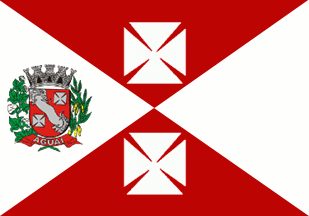 image by Dirk Schönberger, 2 September 2012
image by Dirk Schönberger, 2 September 2012Source: http://pt.wikipedia.org/wiki/Agua%C3%AD

Last modified: 2012-12-29 by ian macdonald
Keywords: sao paulo | aguaí |
Links: FOTW homepage |
search |
disclaimer and copyright |
write us |
mirrors
 image by Dirk Schönberger, 2 September 2012
image by Dirk Schönberger, 2 September 2012
Source:
http://pt.wikipedia.org/wiki/Agua%C3%AD
Divided per saltire, red over white, with the municipal arms in the hoist quarter, and a white Maltese cross in each red quarter.
Official website at
http://www.aguai.sp.gov.br
Dirk Schönberger, 2 September 2012
Aguaí emerged as a settlement named Cascavel, established around the railway station inaugurated on 1 January 1887 by the Mogi Railway Company. Major João Joaquim Braga, considered as the founder of the town, obtained in 1889 the set up of a post office and of a police station. The district of Cascavel, part of São João da Boa Vista, was established on 4 August 1898. The municipality of Aguaí was established on 30 November 1944 and inaugurated on 1 January 1948.
The coat of arms of Aguaí, designed by Lauro Ribeiro Escobar, is "Gules a bend wavy mouthed by two snakes and surrounded by two Maltese crosses all argent. The shield surmounted by an eight-towered mural crown argent ports sable. The shield supported dexter by a plant of cotton and sinister by a plant of soybean the two fructed proper. Below the shield a scroll gules inscribed with the toponym in letters argent."
The rounded-off, or Iberic, shield, used in Portugal at the time of
discovery of Brazil, is a tribute to the early colonizers and builders
of the country.
Gules (red) is a symbol of audacity, valour, courage, valiance,
nobleness, triumph and honour, recalling the courage of the first
colonizers of the region.
The bend wavy represents the water resources of the region. The snakes
are symbol of strength and highness, recalling the early name of the
place, Cascavel (lit., "rattlesnake").
The crosses evokes the Christian faith of the inhabitants and their
devotion to Jesus Christ, the town's patron saint.
Argent is a symbol of felicity, purity, temperance, truth, frankness,
beauty, integrity and friendship.
The mural crown is a symbol of political emancipation. The open ports
are a symbol of hospitality.
Cotton and soybean are important products of the fertile and generous
soil.
http://www.aguai.sp.gov.br/home/historia.php?name=bra - Municipal
website
Ivan Sache, 21 December 2012